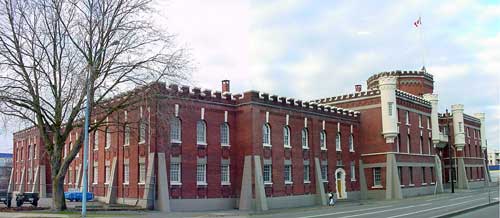ARCHITECTURE:
This impressive brick armoury mimics a medieval castle, with its square outer defensive wall pierced by massive doors guarded with twin towers and a portcullis, but no drawbridge. Inside, offices, mess halls and other facilities face into a central covered vast parade square. An octagonal four-storey tower, behind the entrance, with flagpole and chimney, replicates an ancient keep. The recessed, quoined entrance has a keystone dated 1915, and outer and inner arches separated by the portcullis. A bracketed balcony above the entrance arch connects the corner bays, both with turrets in the corners. A triple-arched window with colonettes and corbelled cornice supporting a row of quoined arches further enhance the keep. The entire armoury has crenellated parapets with contrasting concrete caps. In a further show of strength, all corners at the base have tapered buttresses with rusticated joints to match the stone block effect of the foundation. Most windows are arched, some with keystones, and the floor windows are multi-paned double-hung wooden sashes. The fine brickwork is evident.
ORIGINAL OCCUPANTS:
In the early years of the 20th Century, the military community of Greater Victoria was preparing for war, and a replacement for the Drill Hall on Menzies St (421-431 Menzies St, James Bay) was needed. Although it is similar to many armouries built across Canada, the Bay St Armoury is much bigger than was originally intended. The “standard” plan of the period, from the Dept of Militia in Ottawa, was considered inadequate and after some negotiation a revised plan prepared by architect, Col. Ridgway-Wilson [5th BC Field Regiment, Royal Canadian Artillery] was accepted. He also designed the Church of St. John the Divine (1611 Quadra St, North Park) and Wilkinson Rd Jail, 4216 Wilkinson Rd (Saanich Designated Heritage), built in a similar style as the Armoury a year earlier. Parfitt Bros completed construction of the Armoury in late 1915, at a final cost of $237,000.
The scale of the Armoury, providing room for both infantry and artillery regiments, reflected the burgeoning militarism of the era after Canada’s involvement in the Boer War. Features of the revised plan included living quarters for officers and other ranks, band rehearsal space in the tower, and recreational facilities – swimming pool, gymnasium, bowling alley and miniature rifle range – in addition to a large drill hall, offices, meeting rooms, canteen, mess rooms, reading rooms and caretaker’s quarters.
The drill hall was a popular venue for social and sporting events, the $100 rental going to BC Returned Soldiers’ Commission. Events included the 1924 championship boxing contest for lightweight title of Canada between Joe Bayley (Victoria Sports Hall of Fame 2006) of Esquimalt (his parents had the Halfway House) and Billy Allen of Ottawa, and the annual Victoria Police Mutual Benefit Assoc dance. In 1921 the Assoc paid for a new floor in the drill hall.
The Armoury is headquarters for the Canadian Scottish Reserve (Princess Mary’s) and the 5th BC Field Regiment, Royal Canadian Artillery. Princess Mary, the Princess Royal, Colonel-in-Chief of the Regiment; visited in 1955 and in 1962. Princess Alexandra of Kent subsequently assumed the position and she visited in 1980 to open the regimental museum and again in 1989 to present the new Queen’s Colours to her regiment. HM Queen Elizabeth and HRH Prince Phillip visited in 1971 when the Prince presented Duke of Edinburgh awards and reviewed the cadet corps. The Royal United Services Institute of Vancouver Island (RUSI-VI) also meet here. Both regiments maintain museums here.
In November 2015, military organizations and community heritage and historical groups came together to celebrate the 100th Anniversary of the Armoury. Although recognized nationally, the Armoury is not yet on Victoria’s Heritage Register.

